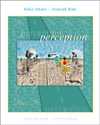| absolute distance | The distance from an observer to an object. See relative distance.
|
 |
 |
 |
| accommodation | The variation in the eye's optical power brought about by temporary changes in the shape of the lens.
|
 |
 |
 |
| aerial perspective | The tendency for objects at a distance to appear less distinct, since light reflected from those objects must travel through atmosphere containing particles of dirt and water.
|
 |
 |
 |
| amodal completion | Perception of an object's occluded region(s).
|
 |
 |
 |
| Ames room | A specially constructed room in which the floor-to-ceiling heights as well as the sizes and shapes of the doors and windows have been distorted to make the room appear rectangular when viewed from one specific vantage point. To an observer looking into the room through a peephole, people of identical heights standing in different parts of the room look dramatically different in height. The Ames room illustrates how perceived distance influences perceived size.
|
 |
 |
 |
| binocular rivalry | The alternation of a percept over time between one eye's view and the other eye's view when the two eyes view very different stimuli.
|
 |
 |
 |
| convergence | The ability of the eyes to turn inward, toward each other, in order to fixate a nearby object.
|
 |
 |
 |
| convergence insufficiency | Difficulty with turning the eyes inward to fixate a nearby object.
|
 |
 |
 |
| depth perception | The ability to perceive the three-dimensional locations of objects in relation to the perceiver's position in space. Besides specifying distance, depth perception allows a perceiver to segregate objects from their backgrounds and to discern the three-dimensional shapes of objects.
|
 |
 |
 |
| diplopia | Double vision, a condition that results when images from the two eyes are seen separately and simultaneously.
|
 |
 |
 |
| disparity-selective cells | Cells in the visual cortex that receive input from both eyes and that respond only when an object is situated at a particular distance from the two eyes. See stereoblindness.
|
 |
 |
 |
| egocentric direction | The direction in which an object is located relative to an observer.
|
 |
 |
 |
| horopter | An imaginary plane in visual space that contains objects whose images fall on corresponding points of the retina of the left and right eyes; any object situated on the horopter will be seen as single.
|
 |
 |
 |
| interposition | A monocular depth cue based
on occlusion of a distant object by a closer one.
|
 |
 |
 |
| linear perspective | The convergence of lines that makes a two-dimensional representation of a scene appear to be three-dimensional.
|
 |
 |
 |
| motion parallax | A source of potent monocular depth information based on differences in relative motion between images of objects located at different distances from an observer.
|
 |
 |
 |
| neon spreading | The illusory migration of color from one region into neighboring regions.
|
 |
 |
 |
| oculomotor cues | Kinesthetic cues to depth derived from muscular contractions of the extraocular muscles.
|
 |
 |
 |
| perceived distance | The apparent visual separation between two objects or between an object and the viewer.
|
 |
 |
 |
| random-dot stereogram | A pair of pictures composed of black and white dots randomly positioned within the pictures; when such pictures are viewed stereoscopically (one picture seen by each eye), a vivid sensation of depth results, making an object appear to stand out from its surroundings.
|
 |
 |
 |
| relative distance | The distance between two objects. See absolute distance.
|
 |
 |
 |
| retinal disparity | A slight difference in lateral separation between objects seen by the left eye and by the right eye; makes stereopsis possible. See stereopsis.
|
 |
 |
 |
| shading | A gradient in the level of reflected light across the surface of a three-dimensional object. This gradient provides a cue to depth, since flat, two-dimensional surfaces don’t cast shadows.
|
 |
 |
 |
| size constancy | The tendency for an object's perceived size to remain constant despite changes in the size of the retinal image of that object as viewing distance varies.
|
 |
 |
 |
| stereoblindness | The inability to see depth using retinal disparity information, a condition thought to result from a reduction in the number of binocular visual cells in the visual cortex. See disparity-selective cells.
|
 |
 |
 |
| stereopsis | Binocular depth perception based on retinal disparity. See retinal disparity.
|
 |
 |
 |
| stereoscope | An optical device for presenting pictures separately to the two eyes.
|
 |
 |
 |
| strabismus | Squint; a condition in which the two eyes are misaligned, making normal binocular fixation impossible.
|
 |
 |
 |
| texture gradient | A form of perspective in which the density of a surface's texture increases with distance, providing information about the slant of the surface.
|
 |
 |
 |
| transparency | The property of a nonopaque object that makes it possible to see other objects located behind the nonopaque one. Transparency implies depth without occlusion.
|
 |
 |
 |
| visual cues | Sources of depth information based on monocular and binocular image properties.
|



 2002 McGraw-Hill Higher Education
2002 McGraw-Hill Higher Education

 2002 McGraw-Hill Higher Education
2002 McGraw-Hill Higher Education